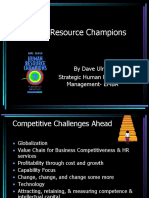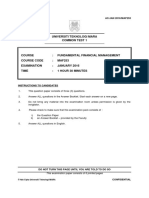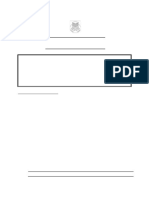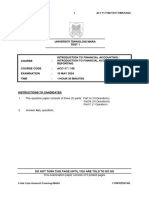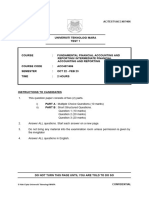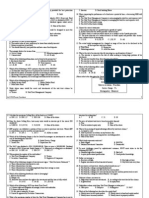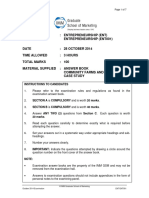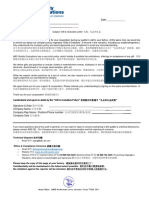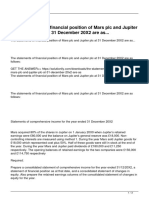Sample Fe Maf253 - Q
Sample Fe Maf253 - Q
Uploaded by
anis sofiaCopyright:
Available Formats
Sample Fe Maf253 - Q
Sample Fe Maf253 - Q
Uploaded by
anis sofiaOriginal Title
Copyright
Available Formats
Share this document
Did you find this document useful?
Is this content inappropriate?
Copyright:
Available Formats
Sample Fe Maf253 - Q
Sample Fe Maf253 - Q
Uploaded by
anis sofiaCopyright:
Available Formats
CONFIDENTIAL AC/SAMPLE/MAF253
UNIVERSITI TEKNOLOGI MARA
SAMPLE
FINAL EXAMINATION
COURSE : FUNDAMENTALS OF FINANCIAL MANAGEMENT
COURSE CODE : MAF253
EXAMINATION : SAMPLE
TIME : 3 HOURS
INSTRUCTIONS TO CANDIDATES
1. This question paper consists of two (2) PART A (10 Questions)
parts:
PART B (4 Questions)
2. Answer ALL questions in the Answer Booklet. Start each answer on a new page.
3. Do not bring any material into the examination room unless permission is given by
the invigilator.
4. Please check to make sure that this examination pack consists of :
i) the Question Paper
ii) A Four-page appendix
iii) an Answer Booklet – provided by the Faculty
5. Answer ALL questions in English.
DO NOT TURN THIS PAGE UNTIL YOU ARE TOLD TO DO SO
© Hak Cipta Universiti Teknologi MARA CONFIDENTIAL
CONFIDENTIAL AC/SAMPLE/MAF253
This examination paper consists of 8 printed pages
© Hak Cipta Universiti Teknologi MARA CONFIDENTIAL
CONFIDENTIAL 3 AC/SAMPLE/MAF253
PART A
This part consists of TEN (10) multiple choice questions. Choose the most suitable
answer for each question and write the corresponding alphabet representing the
answer in the answer booklet.
1. Enhancing the wealth of the _______ is the ultimate goal of wealth maximization.
A. employees
B. financial managers
C. customers
D. shareholders
(1 mark)
2. In achieving shareholders’ wealth maximization, the firm must
A. sell its share at the highest price.
B. have growth in earnings and dividend.
C. maximise its profit.
D. accept as many projects as possible.
(1 mark)
3. The role of _______ is to supply funds to the demander of funds.
A. investor
B. financial market
C. financial manager
D. regulator
(1 mark)
4. The decision function of financial management can be broken down into
the _______ decisions.
A. capital budgeting, cash management and credit management
B. financing and investment
C. investment, financing and asset management
D. financing and dividend
(1 mark)
5. Which of the following financial instruments is not used in the capital markets?
A. Government bonds.
B. Preference stocks.
C. Commercial paper.
D. Common stocks.
(1 mark)
© Hak Cipta Universiti Teknologi MARA CONFIDENTIAL
CONFIDENTIAL 4 AC/SAMPLE/MAF253
6. Which of the following is NOT a component of the financial environment?
A. Financial managers
B. Employees
C. Financial institutions
D. Investors
(1 mark)
7. Which of the following is NOT an advantage of shareholders’ wealth maximization?
A. The goal consider uncertainty when making financial decision.
B. The goal stresses on the efficient use of capital resources.
C. The goal considers economic expectations.
D. The goal stresses on market price per share.
(1 mark)
8. Which statement is TRUE?
A. Capital markets are markets that deals with loans that is backed by
inventories.
B. Money markets are markets that deals with unsecured loan.
C. Primary markets are market that deals with new securities being bought and
sold for the first time.
D. Secondary markets are market that deals with loans that is backed by
accounts receivable.
(1 mark)
9. This type of risk is avoidable through proper diversification.
A. Unsystematic risk
B. Total risk
C. Systematic risk
D. Portfolio risk
(1 mark)
10. _______ is the required of return for investment in government securities.
A. Discount rate
B. Federal interest rate
C. Risk-free rate
D. Prime rate
(1 mark)
(Total: 10 marks)
© Hak Cipta Universiti Teknologi MARA CONFIDENTIAL
CONFIDENTIAL 5 AC/SAMPLE/MAF253
PART B
QUESTION 1
Due to the increasing demand for its product, Sejiwa Sdn Bhd, a manufacturing firm, has
decided to apply for a bank loan to finance the installation of a new production line. In order
to evaluate the company as a potential borrower, the bank would like to compare the
company with companies in the same industry. The company’s most recent financial
statements were presented to the bank to support its loan application:
Sejiwa Sdn Bhd
Statement of Comprehensive Income for the Year Ended 30 June 2020
RM RM
Sales (all credit) 3,700,000
Less: Cost of goods sold 1,960,000
Gross profits 1,740,000
Less: Operating expenses
General and administrative expenses 450,000
Depreciation expense 250,000 700,000
Operating profits 1,040,000
Less: Interest expense 100,000
Before-tax profits 940,000
Less: Taxes 235,000
After-tax profits 705,000
Sejiwa Sdn Bhd
Statement of Financial Position as at 30 June 2020
RM
Cash 98,000
Marketable securities 55,500
Accounts receivable 279,000
Inventories 400,000
Prepaid expenses 10,000
Total current assets 842,500
Net fixed assets 2,100,000
Total assets 2,942,500
Accounts payable 350,000
Notes payable 200,000
Other current liabilities 40,000
Total current liabilities 590,000
Long-term debt 900,000
Ordinary shares 600,000
Retained earnings 852,500
Total liabilities and shareholders’ equity 2,942,500
© Hak Cipta Universiti Teknologi MARA CONFIDENTIAL
CONFIDENTIAL 6 AC/SAMPLE/MAF253
The industry average ratios are provided below to facilitate an analysis of the firm’s loan
request:
Industry Average Ratios
Current ratio 1.40 times
Quick ratio 1.10 times
Inventory turnover 6.00 times
Average collection period 30 days
Total asset turnover 1.20 times
Debt ratio 40%
Times interest earned 11.00 times
Gross profit margin 32.00%
Operating profit margin 20.00%
Required:
a. Compute the above ratios for Sejiwa Sdn Bhd for the year 2020.
(10 marks)
b. Comment on the company’s liquidity and leverage position. Should the loan be
approved?
(5 marks)
(Total: 15 marks)
© Hak Cipta Universiti Teknologi MARA CONFIDENTIAL
CONFIDENTIAL 7 AC/SAMPLE/MAF253
QUESTION 2
A. The following is the Statement of Financial Position (extract) of Black Sea Bhd as at
31 December 2019.
RM
Non-current assets 600,000
Inventories 200,000
Accounts receivable 250,000
Bank 450,000
1,500,000
Ordinary shares 550,000
Preference shares 200,000
Accounts payable 450,000
Accrued expenses 300,000
1,500,000
The financial manager identified that 40% of the current assets were permanent.
Required:
a. Comment on the financing strategies adopted by Black Sea Bhd by showing
clearly the permanent current assets and temporary current assets.
(3 marks)
b. Assess the risk and return trade-off of the financing strategies adopted by
Black Sea Bhd
(2 marks)
B. Semangat Waja Bhd is facing cash flows difficulties during the year, but the financial
manager is trying to manage their cash more efficiently. The company’s annual
operating cycle investment is RM900,000. Inventories turnover is 12 times a year and
receivables are collected in 45 days. Suppliers are paid approximately 35 days after
they arise.
(Assume a 360-day year)
Required:
a. Calculate the company’s cash conversion cycle.
(2 marks)
b. Calculate the amount of financing required by Semangat Waja Bhd to support
its cash conversion cycle.
(2 marks)
© Hak Cipta Universiti Teknologi MARA CONFIDENTIAL
CONFIDENTIAL 8 AC/SAMPLE/MAF253
c. The financial manager of Semangat Waja Bhd has come up with a new cash
management plan to reduce its current cash conversion cycle. The company
has developed a new processing system that would reduce the production
time by 3 days. On top of that, the company had also come up with an
agreement with its supplier to delay payment by 5 days.
Calculate the annual interest savings for the company due to the new cash
management plan, given that a 12% interest is charged on resources
obtained.
(3 marks)
C. Magic Colour Bhd has been offered a new credit terms of 2/15 net 30 by its existing
supplier. Due to cash flow problem, Magic Colour can only pay on day 60 and is
agreeable with the supplier. The company needs RM285,000 to pay within the
discount period to its supplier. The following alternatives was identified to raise the
needed funds.
Alternative 1
Blue Bank is willing to provide a loan for six months at 12% interest with 10%
compensating balance.
Alternative 2
Red Bank has a new promotion and is willing provide a loan for six months at 10%
interest paid in advance with 15% compensating balance.
Required:
a. Identify the effective annual cost of foregoing the cash discount.
(2 marks)
b. Calculate the effective annualised cost of each alternative.
(6 marks)
c. Advise Magic Colour Bhd on the best option for the company.
(3 marks)
(Total: 23 marks)
© Hak Cipta Universiti Teknologi MARA CONFIDENTIAL
CONFIDENTIAL 9 AC/SAMPLE/MAF253
QUESTION 3
A. Shahriman has just graduated from a local university. He is planning to buy his
dream house in five years. Currently, the price of the house is RM500,000 and the
price is expected to increase by 10% in value every year. He plans to pay 20%
deposit on the house by making savings at the end of each year for the next 5 years
and expects to earn 15% interest per year.
Required:
Calculate the annual savings Shahriman should make at the end of each year for the
next 5 years as to have enough money to pay for the house deposit.
(6 marks)
B. Ikleama plans to purchase a new car for RM100,000 and pay RM10,000 as a
deposit. He agrees to pay the balance using a loan, where installment is paid at the
end of each year for the next 7 years. Interest is charged at 4% per year on unpaid
amount.
Required:
a. Calculate the yearly installment of the car loan.
(2 marks)
b. Tabulate the loan amortization schedule for the first 2 years.
(4 marks)
c. Ikleama had saved the RM10,000 deposit through an account that pays 5%.
He had diligently put in RM1,228.20 at the end of each year into the account.
Determine the duration of his investment.
(4 marks)
C. Kenanga is considering investing her money either in Belalang Bhd or Coconut Bhd.
The information for both companies is as follows:
Belalang Bhd Coconut Bhd
Probability Return Probability Return
50% 30% 40% 20%
40% 20% 40% 15%
10% -5% 20% 10%
Required:
a. Identify the expected return for both companies.
(3 marks)
b. Determine the coefficient of variation for both companies.
© Hak Cipta Universiti Teknologi MARA CONFIDENTIAL
CONFIDENTIAL 10 AC/SAMPLE/MAF253
(3 marks)
(Total: 22 marks)
QUESTION 4
A. Barjana Sdn Bhd is considering purchasing new machines worth RM2,730,000 with a
5-year life expectancy. It will be depreciated using the straight-line method over 5
years. The new machines will replace the old machines purchased at RM4,000,000,
which still have a four-year lifetime. The old machines’ useful life is ten years, with a
book value of RM30,000 at the end of its life.
As new machines are faster than the old machines, it requires additional work in
process inventory of RM500,000. The old machines can be sold as scrap for
RM30,000. However, if it is sold now, the company can get RM1,000,000. The
company has paid RM30,000 and RM40,000 for transportation costs and installation
costs respectively, for assembling the new machines.
The following information was extracted from the data usage of the new machines:
i. Reduced salaries by RM250,000 per year.
ii. Reduced utilities expenses by RM170,000 per annum.
iii. Reduced wastage from RM300,000 to RM100,000 per annum.
iv. Increased maintenance expenses by RM10,000 per annum.
The company has also conducted feasibility study for the new machines last month
at a cost of RM80,000. The forecasted training cost for the new machines is
RM130,000.
The company’s required rate of return is 12% and the tax rate is 25%. The desired
payback period is 5 years.
Required:
a. Calculate:
i. Initial outlay
ii. Annual differential cash flow
iii. Terminal cash flow
(10 marks)
b. Analyse:
i. Net Present Value
ii. Internal rate of return
iii. Payback period
(5 marks)
c. Advise the management whether the company should proceed with buying
the new machines. Give reasons for your answer.
(5 marks)
© Hak Cipta Universiti Teknologi MARA CONFIDENTIAL
CONFIDENTIAL 11 AC/SAMPLE/MAF253
B. Tandang Berhad is considering a project which will cost them an initial RM20,000.
The sales expected for the 2-year duration are RM20,000 per annum. The variable
costs are RM 2,000 per annum. The cost of capital 10%. The CEO of the company
wants to know how much the changes of project variables affected the NPV.
Required:
a. Calculate the sensitivity margin of:
i. The initial investment
ii. The variable costs of the projects
iii. The sales of the project
(8 marks)
b. Analyse the sensitivity margin of any TWO (2) above variables.
(2 marks)
(Total: 30 marks)
END OF QUESTION PAPER
© Hak Cipta Universiti Teknologi MARA CONFIDENTIAL
You might also like
- SIE Exam Practice Question Workbook: Seven Full-Length Practice Exams (2024 Edition)From EverandSIE Exam Practice Question Workbook: Seven Full-Length Practice Exams (2024 Edition)Rating: 5 out of 5 stars5/5 (1)
- Yunexpress VN Introduction PDFDocument24 pagesYunexpress VN Introduction PDFKhanh TranNo ratings yet
- Managerial Economics 7th Edition Keat TeDocument5 pagesManagerial Economics 7th Edition Keat Tenabil100% (1)
- A Supply Chain Analysis of Canned Pineapple Juice in Philippine Fruits International, IncorporatedDocument9 pagesA Supply Chain Analysis of Canned Pineapple Juice in Philippine Fruits International, Incorporatednuruddin d darimbangNo ratings yet
- Dave Ulrich-Human Resource ChampionsDocument10 pagesDave Ulrich-Human Resource ChampionsuhrNo ratings yet
- Huawei Technologies Case StudyDocument27 pagesHuawei Technologies Case StudyNiña CarilloNo ratings yet
- Universiti Teknologi Mara Final Examination: Confidential 1 AC/JULY 2021/MAF253Document9 pagesUniversiti Teknologi Mara Final Examination: Confidential 1 AC/JULY 2021/MAF253Nurul Hassanah Binti Hamzah PTNo ratings yet
- CT Maf253 Q Oct2018Document6 pagesCT Maf253 Q Oct2018Nur Anis AqilahNo ratings yet
- Universiti Teknologi Mara Common Test 1: Confidential AC/AUG 2016/MAF253Document6 pagesUniversiti Teknologi Mara Common Test 1: Confidential AC/AUG 2016/MAF253Bonna Della TianamNo ratings yet
- CT - Maf253 Q April2019Document5 pagesCT - Maf253 Q April2019Nur Anis AqilahNo ratings yet
- Maf253 Q Dec 2019Document12 pagesMaf253 Q Dec 2019alisatasnimNo ratings yet
- Faculty Accountancy 2022 Session 1 - Diploma Maf253Document9 pagesFaculty Accountancy 2022 Session 1 - Diploma Maf253mohdazimrmleNo ratings yet
- CT - Maf253 Q Jan2016Document6 pagesCT - Maf253 Q Jan2016Nur Anis AqilahNo ratings yet
- Universiti Teknologi Mara Common Test 1: Confidential AC/AUG 2015/MAF253Document6 pagesUniversiti Teknologi Mara Common Test 1: Confidential AC/AUG 2015/MAF253Bonna Della TianamNo ratings yet
- CT - Maf253 Q Jan2017Document6 pagesCT - Maf253 Q Jan2017Nur Anis AqilahNo ratings yet
- Far110 (Q) Sep 2014 MelDocument12 pagesFar110 (Q) Sep 2014 MelAlieyaaNo ratings yet
- Exam Far110 Dec2019 QuestionDocument10 pagesExam Far110 Dec2019 Questionnafisah rahmanNo ratings yet
- Document 13Document5 pagesDocument 13Bal QisNo ratings yet
- Maf603-Question Test May 2024Document7 pagesMaf603-Question Test May 20242024745885No ratings yet
- Acc407 - Test 1 - Oct22 Feb 23 - QDocument9 pagesAcc407 - Test 1 - Oct22 Feb 23 - Q2023409784No ratings yet
- Maf603-Question Test 1 May 2023Document6 pagesMaf603-Question Test 1 May 20232024745885No ratings yet
- Maf603 Test 1 Dec 2020 - QuestionDocument8 pagesMaf603 Test 1 Dec 2020 - QuestionSITI FATIMAH AZ-ZAHRA ABD WAHIDNo ratings yet
- ED213 - INDIVIDUAL PROJECT - Student Completed AnswerDocument6 pagesED213 - INDIVIDUAL PROJECT - Student Completed AnswerAfifi Iskandar MohamadNo ratings yet
- Test 4Document4 pagesTest 4Dương Thu HàNo ratings yet
- BMI511S - Introduction To Business Management - 2nd Opportunity - January 2016Document9 pagesBMI511S - Introduction To Business Management - 2nd Opportunity - January 2016ZoeNo ratings yet
- Fin Past Years July 2021Document7 pagesFin Past Years July 2021Khairi HuzaifiNo ratings yet
- Set 1 - Maf603-Solution Test May 2024Document7 pagesSet 1 - Maf603-Solution Test May 20242024755227No ratings yet
- Acc117106 Question t1Document6 pagesAcc117106 Question t1Nurin KhairinaNo ratings yet
- Maf603-Question Test Dec 2023Document8 pagesMaf603-Question Test Dec 20232024745885No ratings yet
- CT2 Question PaperDocument8 pagesCT2 Question PaperPunit TewaniNo ratings yet
- may 2022Document6 pagesmay 2022aressarahman72No ratings yet
- Test 1 Q Nov 2022Document6 pagesTest 1 Q Nov 2022syaza aidaNo ratings yet
- Acc406 - Aug 2021 - QDocument12 pagesAcc406 - Aug 2021 - Qtengku rilNo ratings yet
- Qtr4 Wk7 Basic Long Term Financial Concepts Part 2Document8 pagesQtr4 Wk7 Basic Long Term Financial Concepts Part 2harrypot0923No ratings yet
- Faculty Business Management 2021 Session 1 - Degree Fin430Document6 pagesFaculty Business Management 2021 Session 1 - Degree Fin430Mimi SaiziatulNo ratings yet
- Test 1 Q May 2022Document6 pagesTest 1 Q May 2022Amirul AmirNo ratings yet
- Section A: (30 Marks) Part I: Multiple Choice Questions: Confidential Afd 3023 / July - November 2007Document6 pagesSection A: (30 Marks) Part I: Multiple Choice Questions: Confidential Afd 3023 / July - November 2007Vijay ThapliyalNo ratings yet
- MAY2024 ACC117 ACC106 TEST 1 QDocument5 pagesMAY2024 ACC117 ACC106 TEST 1 Q2023167583No ratings yet
- Test 1 Q Dec2021Document6 pagesTest 1 Q Dec2021syaza aidaNo ratings yet
- MAF603-QUESTION TEST 2 - June 2021Document10 pagesMAF603-QUESTION TEST 2 - June 2021fareen faridNo ratings yet
- 2022 Feb T1Document5 pages2022 Feb T1mustardNo ratings yet
- ABU DZAR BIN AHMAD KHAMAL (2023636934) (HM2401A) QUIZ 4 - Test 1 MuazDocument13 pagesABU DZAR BIN AHMAD KHAMAL (2023636934) (HM2401A) QUIZ 4 - Test 1 Muazabudzar0202No ratings yet
- CT Far110 Dec2020 QuestionDocument7 pagesCT Far110 Dec2020 Questionnafisah rahmanNo ratings yet
- ACC030 Comprehensive Project April2018 (Q)Document5 pagesACC030 Comprehensive Project April2018 (Q)Fatin AkmalNo ratings yet
- Universiti Teknologi Mara Test 1: This Test Consists ofDocument6 pagesUniversiti Teknologi Mara Test 1: This Test Consists of2023864756No ratings yet
- Test Feb 2024Document6 pagesTest Feb 20242022452932No ratings yet
- Acc406 - Feb 2021 - Q - Set 1Document14 pagesAcc406 - Feb 2021 - Q - Set 1NABILA NADHIRAH ROSLANNo ratings yet
- Mock 01Document5 pagesMock 01api-26863276100% (1)
- (WWW - Entrance-Exam - Net) - IAI-CT2 - Finance and Financial Reporting Sample Paper 9Document7 pages(WWW - Entrance-Exam - Net) - IAI-CT2 - Finance and Financial Reporting Sample Paper 9Sachin BarthwalNo ratings yet
- PDF Document 2Document6 pagesPDF Document 22024905359No ratings yet
- Untitled documentDocument5 pagesUntitled documentRAMUDU MEDICHETTYNo ratings yet
- Gujarat Technological UniversityDocument4 pagesGujarat Technological UniversityAarvi MangananiNo ratings yet
- PB2-GR10-FM-QP_78725Document4 pagesPB2-GR10-FM-QP_78725Sanvi TuliNo ratings yet
- Document 30Document3 pagesDocument 30Bal QisNo ratings yet
- Business Finance First Quarter ExamDocument4 pagesBusiness Finance First Quarter ExamApril Raylin Rodeo100% (4)
- Acc406 - Q - Set 1 - Sesi 1 July 2020Document12 pagesAcc406 - Q - Set 1 - Sesi 1 July 2020NABILA NADHIRAH ROSLANNo ratings yet
- Exam Far110 Feb2021 QuestionDocument11 pagesExam Far110 Feb2021 Questionnafisah rahmanNo ratings yet
- Paper10 Set1Document8 pagesPaper10 Set13 6 1 4 6 Ganesh Kumaran ANo ratings yet
- CB1 0Document6 pagesCB1 0Nathan RkNo ratings yet
- 2022 Aug T1Document6 pages2022 Aug T1mustardNo ratings yet
- Pathfinder Professional Examination I May 2011Document112 pagesPathfinder Professional Examination I May 2011magnetbox8No ratings yet
- Maf201 Test 2 Jan 2023 QDocument5 pagesMaf201 Test 2 Jan 2023 Qediza adha0% (1)
- ENT001 - Exam Q - 2-2014Document7 pagesENT001 - Exam Q - 2-2014np mariNo ratings yet
- (WWW - Entrance-Exam - Net) - IAI-CT2 - Finance and Financial Reporting Sample Paper 4Document9 pages(WWW - Entrance-Exam - Net) - IAI-CT2 - Finance and Financial Reporting Sample Paper 4Sachin BarthwalNo ratings yet
- Cleanliness Is Next To Godliness EssayDocument4 pagesCleanliness Is Next To Godliness Essayafabeaida100% (2)
- Niroattam Aggarwa 11B BST ProjectDocument21 pagesNiroattam Aggarwa 11B BST ProjectsheeshNo ratings yet
- 7 Habits of Highly Effective Travel Hacking CouplesDocument4 pages7 Habits of Highly Effective Travel Hacking Couplesjack mehiffNo ratings yet
- Consumer Behavior in Clothing Industry and Its Relationship With Open Innovation Dynamics During The COVID-19 PandemicDocument24 pagesConsumer Behavior in Clothing Industry and Its Relationship With Open Innovation Dynamics During The COVID-19 PandemicDat HoangNo ratings yet
- Impact of Product Innovation On Bank Performance (Samuel Omolola Adedoyin)Document60 pagesImpact of Product Innovation On Bank Performance (Samuel Omolola Adedoyin)tobraj043No ratings yet
- DegreePlan (FINA2010 2016)Document13 pagesDegreePlan (FINA2010 2016)إسماعيل البلوشيNo ratings yet
- Gift and Gratuties Letter-Chinese REV2Document1 pageGift and Gratuties Letter-Chinese REV2Tran HuyenNo ratings yet
- Business Multiple ChoiceDocument3 pagesBusiness Multiple ChoiceAbi C. WareNo ratings yet
- Invoice1 - The Califit GymDocument3 pagesInvoice1 - The Califit GymmangeshlalgeNo ratings yet
- Perspectives On Intellectual CapitalDocument254 pagesPerspectives On Intellectual Capitalyenni fayanniNo ratings yet
- Air Cargo GuideDocument211 pagesAir Cargo Guideulya100% (2)
- Kunci Jawab Paket ADocument31 pagesKunci Jawab Paket ASilva Fitri Anjani100% (1)
- Role of Online Marketing in Fashion Industry: Kamna Gupta Sem 4Document20 pagesRole of Online Marketing in Fashion Industry: Kamna Gupta Sem 4Ayushmaan MalviyaNo ratings yet
- Iqra Sp17-Bba-005 Mock 2Document2 pagesIqra Sp17-Bba-005 Mock 2iqra khanNo ratings yet
- SM CiaDocument11 pagesSM CiaishaaneduvNo ratings yet
- Calculating Expected CAC and LTVDocument11 pagesCalculating Expected CAC and LTVmamaNo ratings yet
- MGT 162 Group Assignment Group 5Document16 pagesMGT 162 Group Assignment Group 5muhd najwaNo ratings yet
- The Statements of Financial Position of Mars PLC and Jupiter PLC at 31 December 20x2 Are AsDocument3 pagesThe Statements of Financial Position of Mars PLC and Jupiter PLC at 31 December 20x2 Are AsCharlotteNo ratings yet
- Discussion Topic Week 6Document2 pagesDiscussion Topic Week 6Nurul IzzatiNo ratings yet
- 2024 DBE Live WorkbookDocument39 pages2024 DBE Live WorkbookRaresNo ratings yet
- Contract Law Mock Examination: Date: Time Allowed: One HourDocument6 pagesContract Law Mock Examination: Date: Time Allowed: One Hourfaieza hussainNo ratings yet
- Ge ElecDocument6 pagesGe ElecPaula Rodalyn Mateo100% (1)
- Treasury List 27.04.2020Document1 pageTreasury List 27.04.2020Subhash DhakarNo ratings yet
- Corporate Social Responsibility: UltratechDocument12 pagesCorporate Social Responsibility: UltratechNehaTanejaNo ratings yet
- Engagement of Stakeholders: A Case Study For The TOGAF® 9 Certification Course For People ProgramDocument4 pagesEngagement of Stakeholders: A Case Study For The TOGAF® 9 Certification Course For People ProgramНиколай ТроханNo ratings yet
- The Bonus CommissionDocument2 pagesThe Bonus CommissionThe rockNo ratings yet




